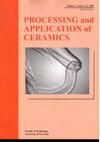工艺参数对溶胶-凝胶/油滴法合成介孔γ-氧化铝颗粒结构的影响:响应面法模拟
IF 0.8
4区 材料科学
Q3 MATERIALS SCIENCE, CERAMICS
引用次数: 0
摘要
采用溶胶-凝胶/油滴造粒技术制备了1.5 ~ 2mm的中孔-Al2O3颗粒,其比表面积和孔体积分别为295m2/g和0.47 cm3/g。采用粉末XRD、DTA、TEM和N2吸附/解吸技术对颗粒结构进行了研究。采用响应面法(RSM)结合CCD方法对工艺变量对颗粒孔隙结构的影响进行建模,自变量(煅烧温度、酸量和氨浓度)与响应(比表面积、平均孔径和孔体积)之间具有二次函数关系。研究了各变量对各响应的交互作用,结果与实验值一致。因此,使用20ml硝酸合成颗粒,在9.25wt中陈化。%氨水,在450℃下煅烧C的性能最好。比表面积预测值为315.64m2/g,孔体积预测值为7 nm,孔体积预测值为0.53 cm3/g,与实验值基本一致。本文章由计算机程序翻译,如有差异,请以英文原文为准。
The effects of processing parameters on structure of mesoporous γ-alumina granules synthesized by sol-gel/oil-drop method: Modelling via response surface methodology
Sol-gel/oil-drop granulation technique was used to prepare mesoporous ?-Al2O3 granules of 1.5-2mm with high specific surface area and pore volume of 295m2/g and 0.47 cm3/g, respectively. The structure of granules was studied using powder XRD, DTA, TEM and N2 adsorption/desorption techniques. A response surface methodology (RSM) holding CCD approach was used for modelling the influence of process variables on the granule pore structure, having a quadratic function relating the independent variables (calcination temperature, acid amount and ammonia concentration) to the responses (specific surface area, mean pore diameter and pore volume). The interaction effect of variables on each response was studied and all were in acceptable accordance with experimental values. Accordingly, the granules synthesized using 20ml of nitric acid, aged in a 9.25wt.% ammonia solution and calcined at 450?C showed the best properties. The predicted values for the specific surface area and pore volume were 315.64m2/g, 7 nm and 0.53 cm3/g, respectively, which were compatible with experimental values.
求助全文
通过发布文献求助,成功后即可免费获取论文全文。
去求助
来源期刊

Processing and Application of Ceramics
MATERIALS SCIENCE, CERAMICS-
CiteScore
1.90
自引率
9.10%
发文量
14
审稿时长
10 weeks
期刊介绍:
Information not localized
 求助内容:
求助内容: 应助结果提醒方式:
应助结果提醒方式:


